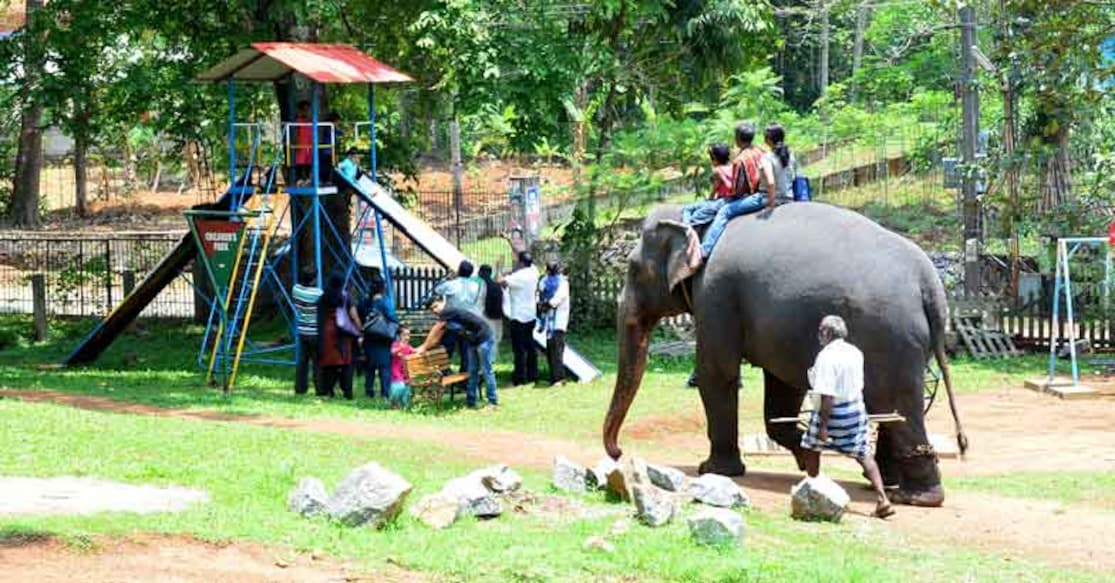The elephant chronicles from Konni

Mail This Article
Ten kilometers out of Pathanamthitta, on the way to Kumbazha, you see the sign board to Konni. And Konni is famous for its 'Aana koodu' or the elephant training camp. A trip here is a must if you love elephants.
The history
Long ago, wild elephants were trapped in pits and tamed using captive elephants. The camp at Konni was one of the major ones in the state. Established in 1942, elephants used to be captured from Mundomuzhi, Mannarappara, and other forests around the area. As soon as a wild elephant fell into a pit, it would be 'outpitted', tamed and trained here by expert mahouts. The elephants would then be used for temple processions and for dragging timber.
Capturing elephants was stopped in 1977. Now, this center in Konni is home to elephants wandering separated from their herds or those that have been hurt in accidents.
The inmates and the routines
A crowd of spectators gathers from early morning at the nine-acre wide premises of Elephant Camp. Two pachyderms, their trunks twisted around loads of palmyrah fronds, offer us welcome. It is as if they signal: 'follow me', through the gates, past a compact herbal garden, and on to the center-piece, the huge elephant “kraal” (the wooden structure where elephants are accommodated).

‘Inmates’ range from Soman, veteran 75-years old trained elephant, to 7-month old little tusker Pinchu. Senior Mahout Hanifa waxed eloquent when we addressed him: “Kampakam (Hopea parviflora) timber has been used for building the cages. It is as strong as steel. The cages can accommodate up to six elephants.
Soman, the first elephant here after the capture was banned. He is now 73 and enjoys a 'pension.' He was found from Konni Thekkuthodu. Priyadarsini, now 35 years old, followed. They had been injured or had wandered away from their herds. Now there are six elephants - Mina (25), Surendran (18), Eva (14), Krishna (5). For each of them, four or five employees have been appointed.
The darlings
The most attractive inmates are Pinchu, 7-month old tusker from Peppara, and Ammu, 10-month old female from Nilambur. Visitors are never tired of gazing at their antics. It is like that: anyone will be fascinated by their playful mischief. Before these two arrived, the youngest here was Lakshmi; she expired last year due to some disease”.

And the tales
The Konni Elephant Camp is part of the Eco-friendly tourist map of Kerala Forest Department. We go on to the Elephant Museum next. The first exhibit is the skeleton of a 45-year old female elephant, brought from Nilambur. All around on the walls is an untold profusion of elephant pictures!
The ideal of Elephantine Beauty comprises a colour black like ebony, a trunk long enough to trail along the ground, long and lustrously white tusks, high twin bumps on the head, a prominent frontal boss, clear eyes, big broad ears, a short muscular neck, a long body, firm strong legs, 18 toe-nails of the same colour, and a long tail stopping short of touching the ground, but with a tuft of thick black hairs at the end. The more you see these glorious creatures, the more deeply you fall in love with them.
We go on to the audio-visual room in the museum. The recorded realism of the sounds of the forest makes us feel that we are indeed in one. We proceed to exhibits of equipment and tools once used for capturing elephants, the rings used to secure the tusks from splintering off, and the chains, the nail-studded probes, the clubs, the long spiked pole and the short elephant prod, and the other instruments of torture used to control the beasts should they revert to wild behaviour. Also on show are the teeth and the knee-caps of the huge animals. As we exit the building, we see the technique for making paper out of elephant dung, but the process has been temporarily discontinued to accommodate the renovation of the buildings.
Feeding time
The food is prepared with ragi, rice, salt, turmeric powder, and palm jaggery (karippetty). Anil, the officer in charge, told us: “This is the main diet. In addition, we give palmyrah and coconut fronds, - about 200 to 250 kg per day to each. And about 250 liters of drinking water each per day. We have put up a big shower bath for them. Sometimes, we take them to the river for bath”. And he stopped talking, as Surendran came up, and opened his mouth wide for the food, now formed into big balls for him. Elephant-lovers can sponsor feeding of the elephants by paying for it. Arrangements for elephant-rides are available: Rs. 800/- for a group of three, and Rs. 600/, if it is only two. Priyadarsini and Mina are generally used for providing the ride.

Jeep rides and Boating
Forest Department arranges jeep rides through Kuttattippara-Chellikkal route – a distance of 61 km that takes 8 hours to traverse! One has to book for it at Konni Eco-tourism Office.
Club this trip with an outing to Adavi, about 10 kms away. A visit to the Elephant Camp at Konni forms part of the Konni Eco- Tourism project.
(Published in arrangement with Manorama Traveller)

